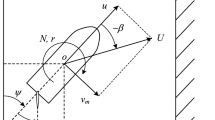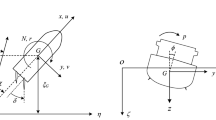Abstract
To realize autonomous ships in the near future, possibility of automatic berthing has been investigated. Automatic berthing is not an easy task because of some complexities that are included in the problem, such as the nonlinearity of the low-speed maneuvering model, danger of collision with berth, etc. In this research, as a first step, the authors solved the off-line automatic berthing problem. Here, the optimal control problem was modeled as minimum-time problem, and the collision risk with the berth was taken into account. The authors attempted to apply the covariance matrix adaption evolution strategy (CMA-ES), which is considered state-of-the-art in evolutionary computation approaches for optimization of real-valued variables. In the problem dealt with here, a propeller and a rudder were used only as control inputs; so, the degree of difficulty was significantly high. Nevertheless, optimal control method based on the CMA-ES successfully gave us the offline results for typical situations considered. It is noteworthy that preparation of a feasible initial control input was not required in the calculation process, which made the proposed procedure robust. The calculation method proposed here is offline, but the results could be applied as an initial guess in an online (real-time) control problem.







Similar content being viewed by others
References
http://www.unmanned-ship.org/munin/. Accessed 25 June 2018
http://www.rolls-royce.com/~/media/Files/R/Rolls-Royce/documents/customers/marine/ship-intel/rr-ship-intel-aawa-8pg.pdf. Accessed 25 June 2018
Takai T, Yoshihisa H (1987) An automatic maneuvering system in berthing. In: Proceedings, 18th ship control symposium, vol 2. The Hague
Takai T, Ohtsu K (1990) Automatic berthing experiments using “Shioji-Maru” (in Japanese). J Jpn Inst Navig 83:267–276
Hasegawa K (1998) Measurement and control techniques of ships. Measurement and control for safety navigation (in Japanese). J Soc Instrum Control Eng 37(11):762–767
Kose K, Fukudo J, Sugano K, Akagi S, Harada M (1986) On a computer aided maneuvering system in harbors (in Japanese). J Soc Nav Arch Jpn 160:103–110
Koyama T, Jin Y, Jin KH (1987) A systematic study on automatic berthing control (1st report) (in Japanese). J Soc Nav Arch Jpn 162:201–210
Yamato H, Uetsuki T, Koyama T (1990) Automatic berthing by the neural controller. In: Proceedings of 9th ship control systems symposium, vol 3, pp 183–201
Hasegawa K, Kitera K (1993) Automatic berthing control system using network and knowledge-base (in Japanese). J Kansai Soc Nav Arch 220:135–143
Yamato H, Koyama T, Nakagawa T (1993) Automatic berthing system using expert system (in Japanese). J Soc Nav Arch Jpn 174:327–337
Shouji K, Ohtsu K (1992) A study on the optimization of ship maneuvering by optimal control theory (1st report) (in Japanese). J Soc Nav Arch Jpn 172:365–373
Wu AK, Miel A et al (1980) Sequential conjugate gradient–restoration algorithm for optimal control problems with nondifferential constraints and boundary conditions Part l. Optim Control Appl Methods 1:69–88
Shouji K, Ohtsu K, Hotta T (1993) A study on the optimization of ship maneuvering by optimal control theory (2nd report) (in Japanese). J Soc Nav Arch Jpn 173:221–229
Shouji K, Ohtsu K (1993) A study on the optimization of ship maneuvering by optimal control theory (3rd report) (in Japanese). J Soc Nav Arch Jpn 174:339–344
Okazaki T, Ohtsu K, Shouji K, Mizuno N (1996) A study on the minimum time stopping problem (in Japanese). J Soc Nav Arch Jpn 180:223–234
Ohtsuka T (2004) A continuation/GMRES method for fast computation of nonlinear receding horizon control. Automatica 40(4):563–574
Hamamatsu M, Kagaya H, Kohno Y (2008) Application of nonlinear receding horizon control for ship maneuvering (in Japanese). Trans Soc Instrum Control Eng 44(8):685–691
Mizuno N, Uchida Y, Okazaki T (2015) Quasi real-time optimal control scheme for automatic berthing. In: 10th IFAC conference on maneuvering and control of marine craft MCMC 2015, vol 48, issue 16, pp 305–312
Maki A, Umeda N, Ueno S (2008) Application of optimal control theory to course keeping problem in following seas (in Japanese). J Jpn Soc Nav Arch Ocean Eng 7:207–212
Maki A, Umeda N, Ueno S (2008) Investigation on broaching-to using optimal control theory. J Jpn Soc Nav Arch Ocean Eng (in Japanese) 8:115–122
Hansen N (2006) The CMA evolution strategy: a comparing review. In: Lozano JA, Larrañaga P, Inza I, Bengoetxea E (eds) Towards a new evolutionary computation. Springer, Berlin, Heidelberg, pp 75–102
Hansen N, Auger A (2014) Principled design of continuous stochastic search: from theory to practice. In: Borenstein Y, Moraglio A (eds) Theory and principled methods for designing metaheustics. Springer, Berlin, Heidelberg, pp 145–180
Yokoyama N, Suzuki S (2003) A numerical method for optimal control problem using genetic algorithm (in Japanese). J Jpn Soc Aeronaut Space Sci 51(592):207–214
Kita H, Ono I, Kobayashi S (2000) Multi-parental extension of the unimodal normal distribution crossover for real-coded genetic algorithms (in Japanese). Trans Soc Instrum Control Eng 36:875–883
Yasukawa H, Yoshimura Y (2015) Introduction of MMG standard method for ship maneuvering predictions. J Mar Sci Technol 20:37–52
Yoshimura Y, Nakao I, Ishibashi A (2008) Unified mathematical model for ocean and harbor maneuvering. In: Proceedings of the international conference on marine simulation and ship maneuverability 2009, pp 116–124
ITTC (2002) Final Report and Recommendations to the 23rd ITTC: the specialist committee on Esso Osaka. In: The proceedings of the 23rd ITTC conference
Ueda N (1985) On the maneuvering motion of a vessel during backing (in Japanese). Master thesis, Osaka University
Hachii T (2004) The prediction of maneuvering motion on ships with low speed using standard MMG model (in Japanese). Master thesis, Osaka University
Fujii H, Tuda T (1961) Experimental research on rudder performance (2) (in Japanese). J Soc Nav Arch Jpn 110:31–42
Kose K, Hinata H, Hashizume Y, Futagawa E (1984) On a mathematical model of maneuvering motions of ships in low speeds (in Japanese). J Soc Nav Arch Jpn 155:132–138
Atamna A, Auger A, Hansen N (2016) Augmented lagrangian constraint handling for CMA-ES—case of a single linear constraint. In: Proc. of the parallel problem solving from nature—PPSN II, Cham, vol 9921, no 2, 2nd edn, pp 181–191
Hansen N (2016) The CMA evolution strategy: a tutorial. arXiv:1604.00772
Sakamoto N, Akimoto Y (2017) Improvement to the box constraint handling method for the CMA-ES and its generalization to linear constraints (in Japanese). Trans Jpn Soc Evolut Comput 8(2):23–35
Sakamoto N, Akimoto Y (2017) Modified box constraint handling for the covariance matrix adaptation evolution strategy. In: Genetic and evolutionary computation conference, Berlin, Germany, July 15–19, 2017, companion material proceedings, pp 183–184
Auger A, Hansen N (2005) A restart CMA evolution strategy with increasing population size. In: Proc. of the 2005 IEEE congress on evolutionary computation, pp 1769–76
Akimoto Y, Nagata Y, Ono I, Kobayashi S (2012) Theoretical foundation for CMA-ES from information geometry perspective. Algorithmica 64(4):698–716
Acknowledgements
The authors are grateful to Mr. Koichi Shouji and Dr. Satoshi Masuda in JMU (Japan Marine United Corporation) for their technical advices and discussions. This work was supported by FY2018 Fundamental Research Developing Association for Shipbuilding and Offshore (REDAS) in Japan. The authors would like to thank Enago (http://www.enago.jp) for the English language review.
Author information
Authors and Affiliations
Corresponding author
Additional information
Publisher's Note
Springer Nature remains neutral with regard to jurisdictional claims in published maps and institutional affiliations.
About this article
Cite this article
Maki, A., Sakamoto, N., Akimoto, Y. et al. Application of optimal control theory based on the evolution strategy (CMA-ES) to automatic berthing. J Mar Sci Technol 25, 221–233 (2020). https://doi.org/10.1007/s00773-019-00642-3
Received:
Accepted:
Published:
Issue Date:
DOI: https://doi.org/10.1007/s00773-019-00642-3




